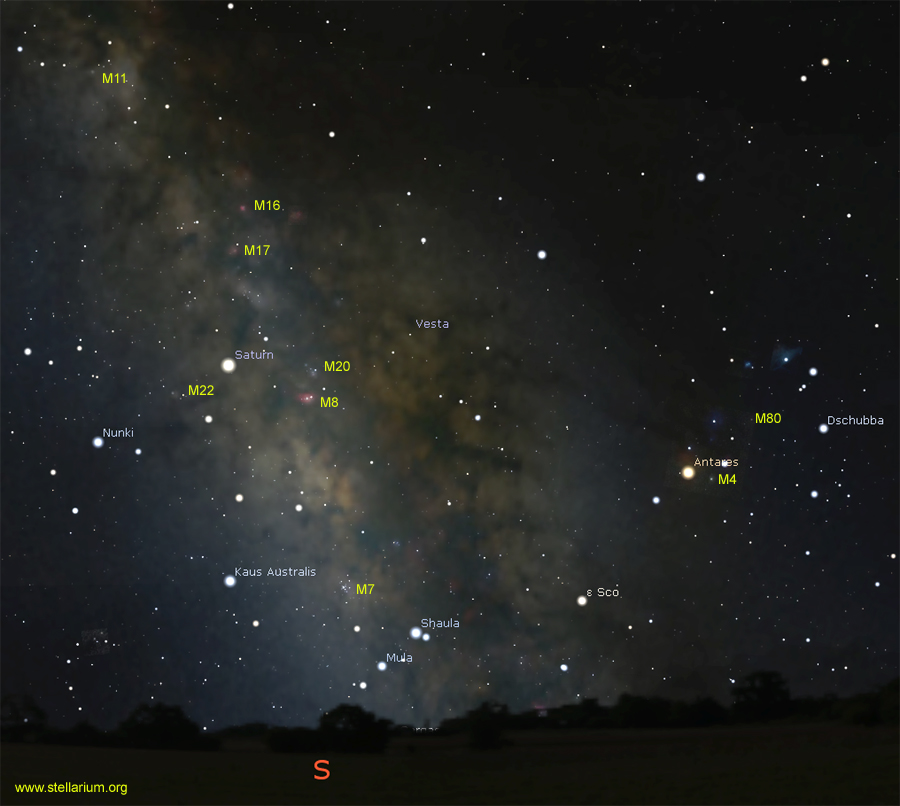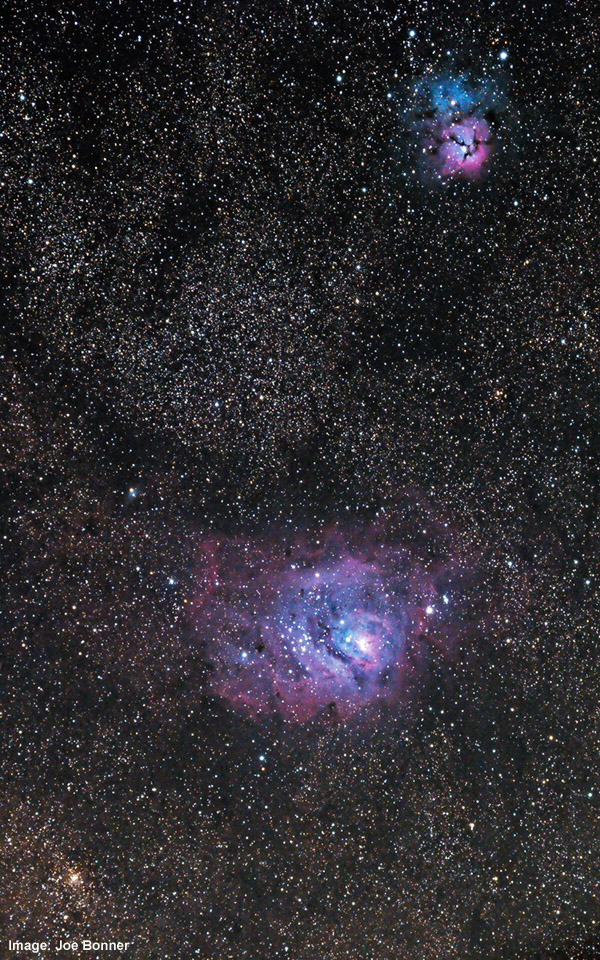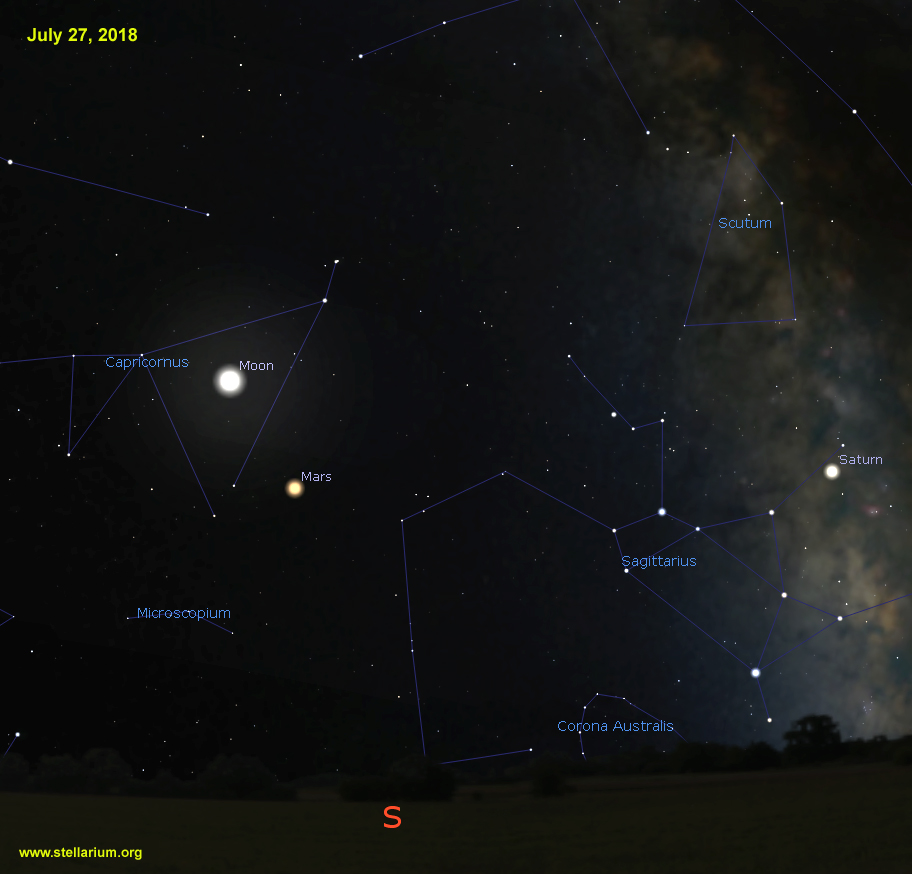The Milky Way and Big Bold Mars
Opposed to the Big Dipper that is seen all year round, Sagittarius the Archer appears low in the south skies for only a few months. With so many celestial objects to hunt down, we definitely have our work cut out.
To fully appreciate the majesty of the night, head out to the countryside on a moonless night and prepared to be dazzled. Looking at Sagittarius as well as the eastern half of Scorpius, there appears to be a misty haze amongst the distant stars. This cosmic haze is the glow of literally billions of suns that make up our Milky Way Galaxy.
One of my favourite globular clusters in Sagittarius is M22. It is located some two and a half degrees to the upper left of the top star of the teapot named Kaus Borealis. In a telescope, it appears as an even distribution of stars. Situated at more than ten thousand light-years (ly) away, M22 houses an estimated 100,000 stars. At magnitude 5.2and is easily picked up without optical aid.

One of the best examples of a stellar nursery is the Lagoon Nebula or M8. Just look a few degrees north of the star Alnasl, a spectral type K1 star located 97 ly away. This star has a brightness that equals 64 times that of the Sun, has a surface temperature of 4800 degrees Kelvin and is 12 times the Sun’s radius.
M8 resides about 5,000 ly away and takes up two lunar diameters of sky. The hydrogen gas cloud is being lit up by hot, infant stars. To the left of the gas cloud is an extremely young cluster catalogued as NGC 6530 containing about 100. A bit north and west is M20 aka the Trifid Nebula. Photos reveal a nice impression of a flower petal of red and blue. Also at 5,000 ly, the Trifid is considered an open cluster with nebulosity.
The next cosmic maternity ward is M17 that goes by a few names such as Swan Nebula, Horseshoe and even the Lobster from observers in the southern hemisphere. Any way you say it, this beautiful shell of interstellar gas and dust is forming an estimated 35 stars which are embedded deep in the nebulosity and not readily resolved. The very young stars are causing the region to glow.
With wide-angle binoculars, you can hunt down numerous interstellar clouds that appear dark by blocking starlight. You will need dark skies and a very clear south. One good star chart for locating these dark objects is the old Skalnate Pleso sky charts which I have owned since the 1970s. Even in our hi-tech world, you still can’t replace the old faithful star charts.
Let’s take a few moments and hop over to Scorpius. The orangey coloured star called Antares is listed at magnitude 1.1 and is the 13th brightest star in the sky. At a distance of about 600 ly, this supergiant star that is so large, if we replaced it with the Sun its boundaries would end somewhere between the asteroid belt and mighty Jupiter.

Moving one and a quarter degrees to the west of Antares is M4, a magnitude 5.6 globular cluster. This loose cluster by nature is estimated to be 7,200 ly from us and close to 75 ly wide. It takes up a little more than the area of the full Moon and contains 43 known variable stars. Ptolemy’s cluster (M7) is large, scattered and shines at magnitude 3.8 and is less than 1,000 ly away. This open cluster is bright enough to reflect off a calm lake. What a sight in any optical instrument.
Move up halfway to the Scorpion’s top claw to locate M80. This is one of the densest globulars in the sky. Large scopes are needed to resolve stars to the center. This 8th magnitude cluster has a diameter of around 90 ly and is estimated to be some 36,000 ly from us. It is pretty rare to hear of a nova in a globular cluster but this was the case in 1860.
Higher up along the Milky Way is one of the prettiest open clusters buried in the Scutum Star Cloud. Commonly known as the Wild Duck Cluster, M11 contains and estimated 500 stars brighter than 14 magnitude. Looking at this object in a telescope, you will see a bright star close to the middle of the cluster. This single sun is simply in the line of sight and not physically part of the cluster.

Venus is still high in the western sky and will form a nice conjunction on July 9 with the star Regulus. Venus is almost half-lit and is spectacular in a telescope. Jupiter is very high in the sky and past the meridian. Every night will show a completely different orientation of the four main Galilean moons and in fact, an elapsed hour will show subtle positional change. A complete timetable of Jupiter’s moons crossing the planet along with their shadows is found in the 2018 RASC Observer’s Handbook. Jupiter sets just after 2 a.m. at the beginning of the month. The moon will be about Jupiter on the 20th which also happens to be the 49th anniversary of humans setting foot on the moon. Saturn is past opposition and is above the southern horizon as the sky darkens.
The long-awaited opposition of Mars occurs on July 27 with the closest approach on the 31st. The planet rises around 11 p.m. on July 1 and by 9 p.m. at month’s end. At is brightest the red planet will even be brighter than Jupiter. Mars will be 57.6 million km from us at its closest compared to 56 million back in 2003. Although our two planets come close about every 26 months, it is the seventh opposition that we get very close. As luck would have it there is a global dust storm occurring on the red planet right now. This is hiding surface detail which would have been spectacular. A total lunar eclipse occurs on the 27th but will not be visible from North America.
This month’s new moon occurs on July 12 with the full moon on the 27.
Until next month, clear skies everyone.
Gary Boyle
